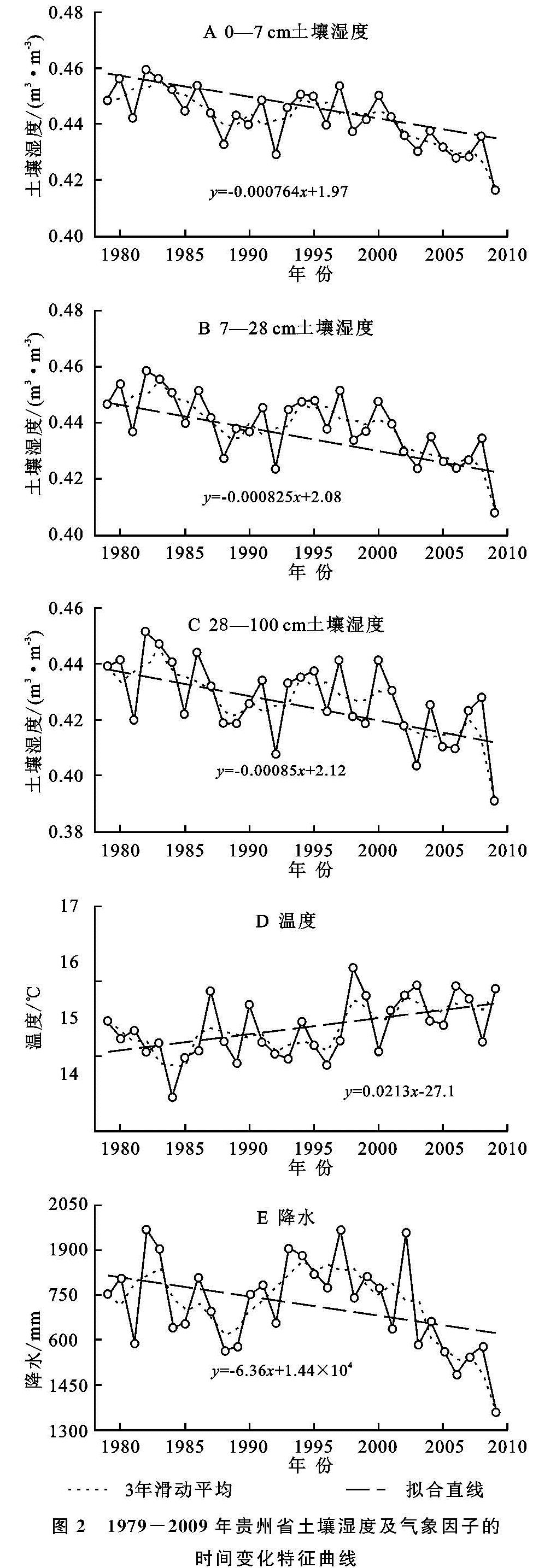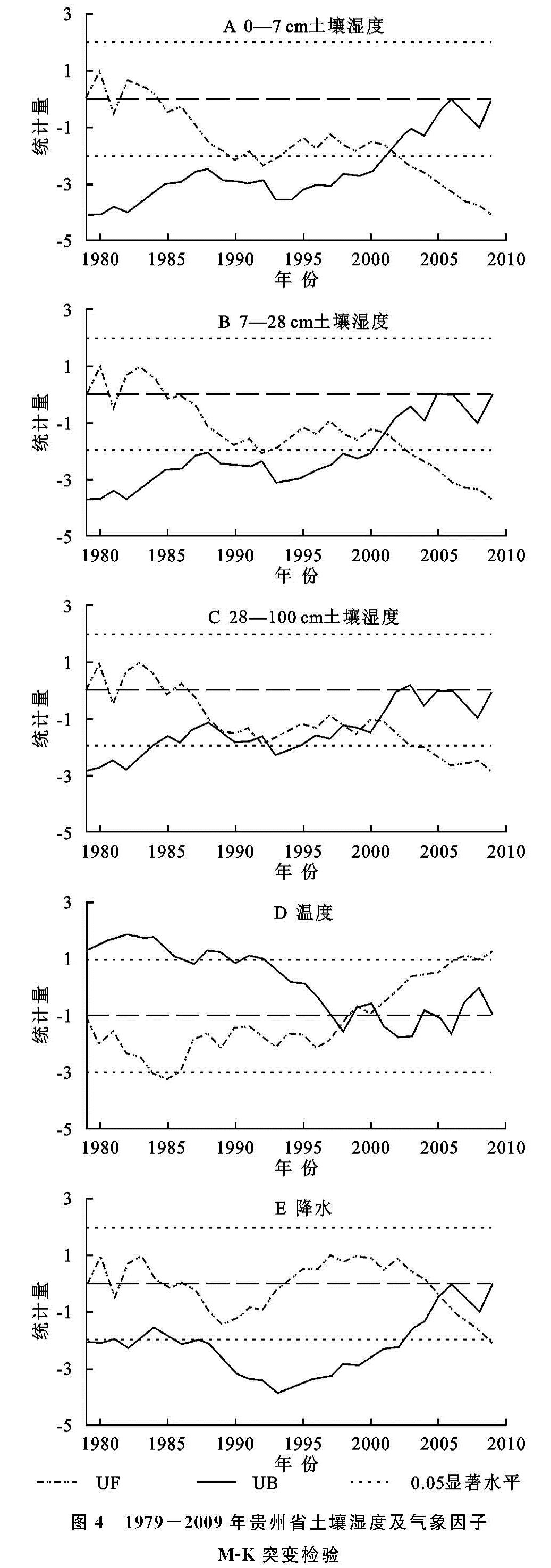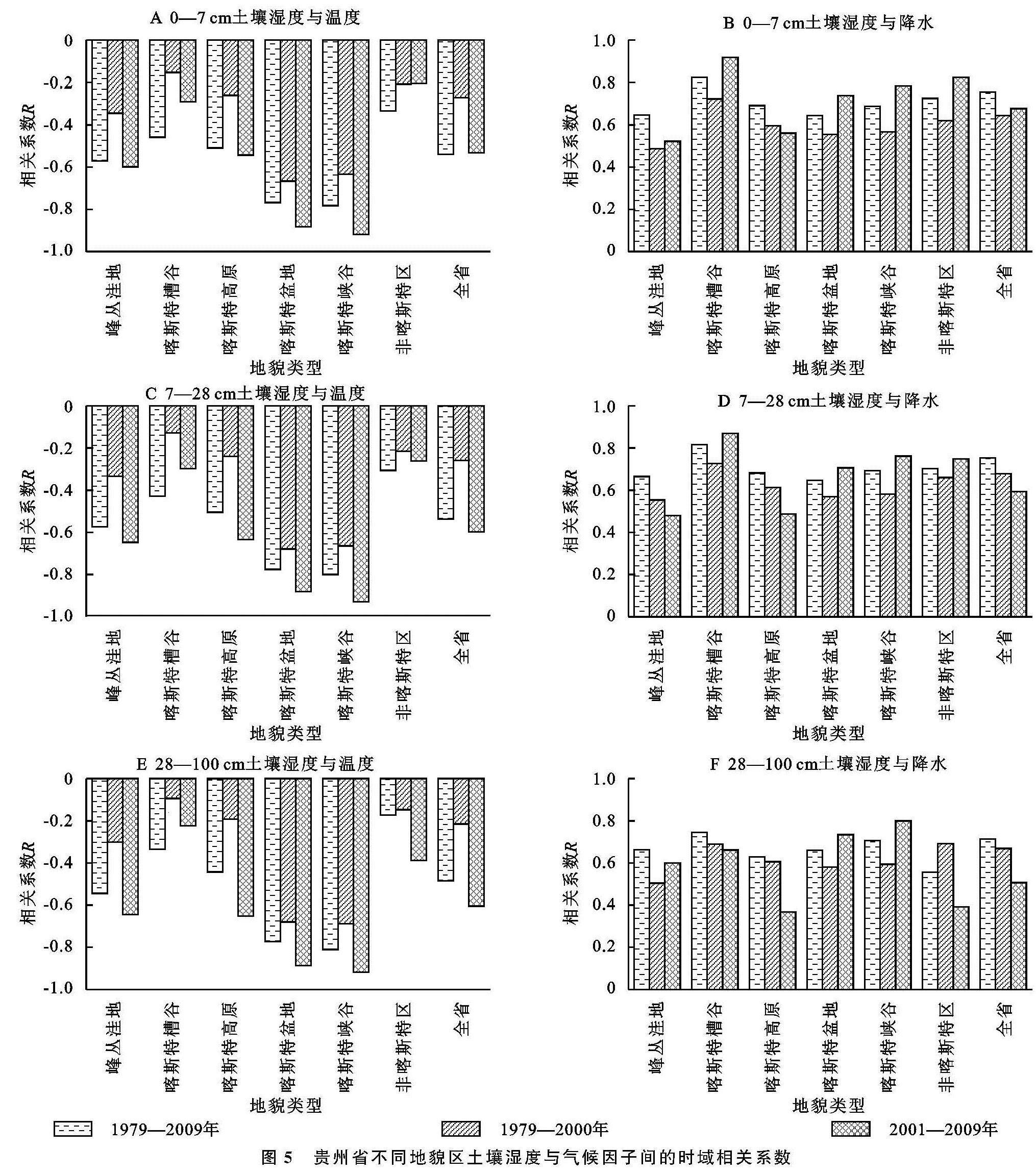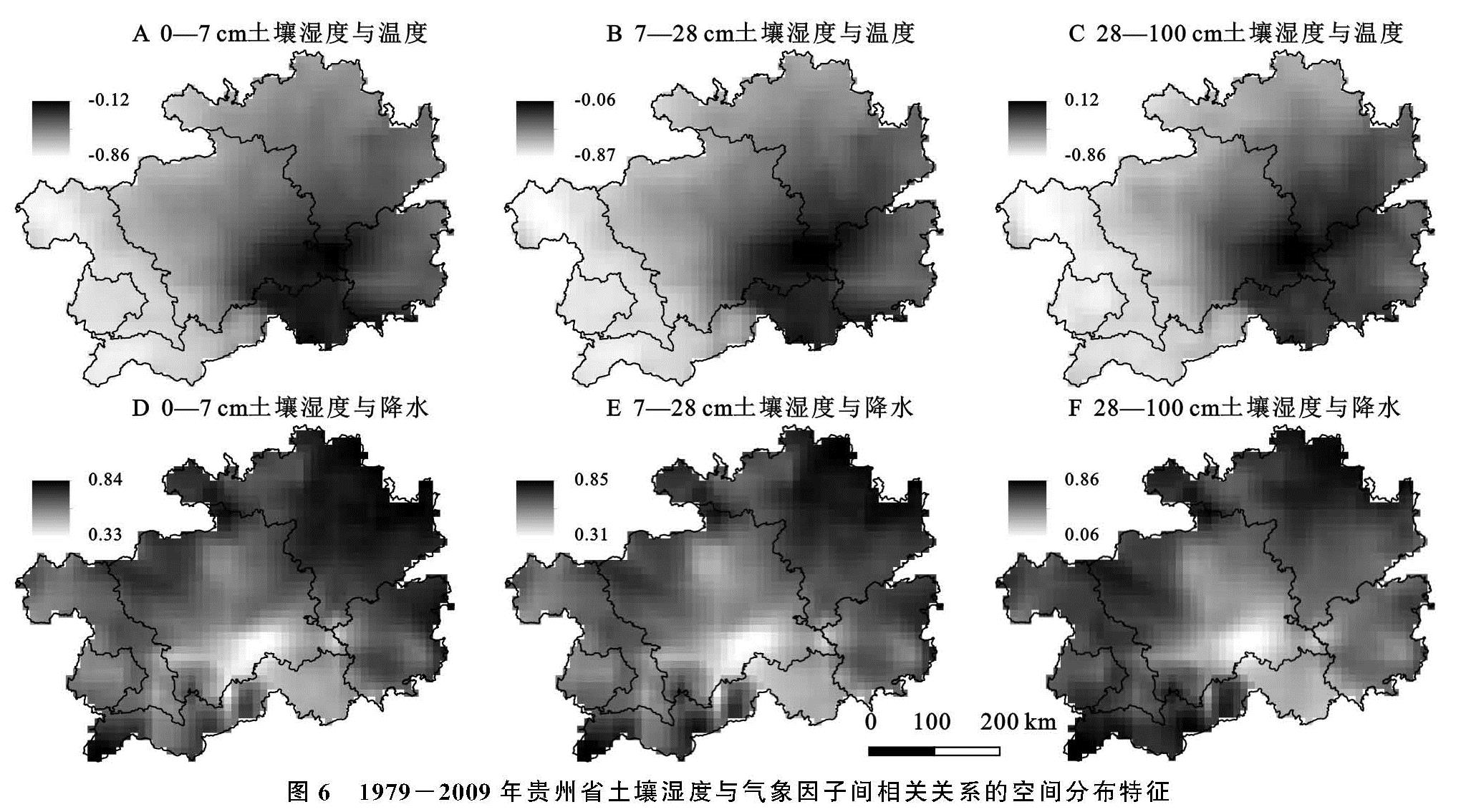3.2.1 土壤湿度与气象因子突变检验
由3.1.1节可知,31 a来研究区不同深度的土壤湿度与气象因子呈波动变化态势,土壤湿度与气象因子可能存在突变现象。基于M-K突变检验与滑动T检验(滑动年数5 a)相结合的方法,对研究区土壤湿度、温度及降水进行突变检验。
M-K突变检验结果见图4。由图4A,4B,4C可知,表层、中层、深层土壤湿度的UF曲线均在1985年附近及以后均小于0,且均在2002年后超过0.05显著水平线,表明不同深度层土壤湿度呈现出显著下降趋势; 由图4D,4E可知,1998年以后研究区温度增温趋势加剧,并在2007年超出显著水平线,上升趋势明显,而2004年前降水长期在“0”刻度上下波动,2004年后呈持续下降趋势。在0.05显著水平线区间,表层、中层土壤湿度的UF与UB曲线相交于2001年左右(图4A,4B),并于2002年后两者呈显著下降趋势,结合滑动T检验分析知,2001年土壤湿度出现的下降突变可信。由图4C可看出,深层土壤湿度的UF与UB曲线在0.05显著水平线区间中存在多个交点(1992年、1998年、2001年),结合下降趋势与滑动T检验,仅2001年为可信突变点。温度的UF与UB曲线同样存在多个交点(1998年、1999年、2000年),且2000年后温度上升明显,表明温度在2000年发生突变。图4E可看出,降水的UF与UB曲线相交于2005年且通过滑动T检验,且在2005年后下降显著。综合几个因素,土壤湿度在2000年后表现为显著降低趋势。
综上所述,基于M-K突变检验、滑动T检验,发现贵州省不同深度层土壤湿度以均在2001年左右发生突变,而温度与降水则分别于2000年和2005年发生突变。为更好揭示土壤湿度与气象因子间的响应关系,以2001年为界,分别对1979—2000年和2001—2009年不同地貌类型下不同深度层土壤湿度与温度及降水间的相关关系进行分析,以期揭示贵州省不同地貌类型下土壤湿度对气候变化的响应以及找出导致研究区土壤湿度突变的主导因素。
3.2.2 土壤湿度与气象因子间的时域相关性
贵州省不同地貌区土壤湿度与气候因子间的相关系数见图5。从全省看,相较于温度,31 a来研究区降水与不同深度层土壤湿度间的相关性更强。其中,表层土壤湿度和中层土壤湿度与降水间的相关性相当,相关系数分别为0.76,0.75(p<0.001),而深层土壤湿度与降水间的相关性稍弱(R=0.71,p<0.001),这主要是因为研究区表层土壤湿度的主要直接来源是降水和降雪,深层土壤的水分是通过表层土壤的渗透而得,顾及蒸发蒸散等的消耗,达到深层土壤的降水较少,从而导致其与降水间的相关性较其他两层弱。各层土壤湿度与温度均呈现出显著负相关,随着深度加深,相关性逐渐减弱。以上表明降水是影响土壤湿度变化的主要因素,而温度的上升可能会造成土壤的干化。
从不同地貌类型看,由于峰丛洼地、喀斯特槽谷、喀斯特高原和非喀斯特区降水较为充沛,地表水资源相对丰富,31 a来对应地区的土壤湿度与降水呈显著正相关,与温度呈显著负相关,且降水对各层土壤湿度的影响更大,这与全省结果相符; 而在喀斯特盆地、喀斯特峡谷区域,各层土壤湿度与温度间的相关性更强,平均相关系数分别约-0.77,-0.80(p<0.01),说明这两种地貌下温度与土壤湿度间的关系更加密切。其次,在同种地貌下,不同深度的土壤湿度与温度、降水间的相关性也有所差异,如喀斯特槽谷和非喀斯特区,深层土壤湿度与温度、降水间的相关性小于表层土壤湿度和中层土壤湿度,而表层、中层土壤湿度与温度、降水的相关性更为显著。
图3 1979-2009年贵州省土壤湿度及气象因子变化趋势的空间分布特征
图4 1979-2009年贵州省土壤湿度及气象因子M-K突变检验
结合土壤湿度突变,相较于2000年以前,2001年以后表层土壤湿度与降水间的相关性增加了约6.25%(R从0.64增加到0.68,二者相关性检验的p<0.05); 中层和深层土壤湿度与降水间的相关性分别减少了13.24%,23.88%,这是由于研究区年降水呈下降趋势,导致土壤入渗深度减小,从而使得降水与土壤湿度间的相关性减弱,这一现象对于深层土壤更为明显; 而土壤湿度与温度间的负相关性却分别增加了96.30%,130.77%,185.71%。从地貌类型看,喀斯特高原地区降水与各层土壤湿度的相关性分别减弱了6.67%,19.67%,39.34%,而与温度的负相关性却分别增强了107.69%,162.5%,242.11%; 峰丛洼地、喀斯特槽谷、喀斯特盆地、喀斯特峡谷土壤湿度与温度、降水间的相关性总体都有不同程度增强(峰丛洼地中层土壤湿度、喀斯特槽谷深层土壤湿度除外),但土壤湿度与温度间的相关性增幅更为明显。其中,峰丛洼地地区土壤湿度与温度间相关性的增幅最为突出,其三层土壤湿度与温度间相关性的增强幅度约为降水的3.4~8.7倍。但也存在一定的例外,如非喀斯特区的表层、中层土壤湿度,以及喀斯特槽谷表层土壤湿度,它们与降水间相关性的增强幅度则大于温度且显著。降水分布的不均匀和区域温度变化的不同,加之不同地貌区岩性、地形、地质构造条件以及岩溶发育特征不尽相同,造就了贵州省不同地貌条件下的土壤湿度与气象因素间相关程度的差异性。
综上所述,1979—2009年贵州省不同地貌下不同土层深度的土壤湿度与温度、降水间的相关性具有差异性,降水是控制土壤湿度变化的主要气候因子,但在全球变暖的趋势下,温度与土壤湿度的负相关性逐渐增强,降雨减少与气温增加可能是造成研究区土壤湿度下降突变的主要因素,以喀斯特高原、峰丛洼地最为突出。温度的上升可能会较大地影响土壤湿度的衰减,并可能会成为驱动土壤湿度变化的主导因素。
3.2.3 土壤湿度与气象因子间相关性的空间分布特征
1979—2009年贵州省不同深度的土壤湿度与气象因子间的相关关系分布见图6。由图6可知,全省土壤湿度整体上与温度的负相关性由东向西递增; 而土壤湿度与降水呈正相关,空间上表现为东高西低的特点,这主要与贵州省降水呈西多东少的分布特征有关。其中,土壤湿度与温度负相关性较高的地区主要为喀斯特峡谷、喀斯特盆地和峰丛洼地东部。土壤湿度与温度也存在正相关的地区,如:喀斯特高原东南部(深层土壤),其原因有待进一步分析。随着土层深度的增加,峰丛洼地土壤湿度与降水间的相关性逐渐增强,但在喀斯特高原地区则有所减弱。喀斯特槽谷土壤湿度与降水的平均相关系数高于其他地貌类型。值得注意的是,在喀斯特高原东南部、峰丛洼地东部各层土壤湿度与温度、降水间的相关性较弱,表明温度和降水可能均不是控制该地区土壤湿度变化的主要因素。
基于3.2.1节中的突变检验结果,分别计算了1979—2000年、2001—2009年贵州省不同深度土壤湿度与气象因子间的相关关系。计算结果表明,相比于1979—2000年、2001—2009年土壤湿度与温度间的正相关性增强,这一现象主要集中在喀斯特高原、喀斯特槽谷、峰丛洼地以及非喀斯特区的交界处。喀斯特槽谷南部土壤湿度与温度间的正相关性随着土层深度的增加逐渐增强,而与降水间的相关性则逐渐减弱。土壤湿度与降水间的正相关性有所增强,但同时也出现了负相关地区,主要分布于喀斯特高原南部地区,并随着土层深度的增加,降水对土壤湿度的抑制作用也随之增强,这有待进一步分析。
综上所述,多年来贵州省土壤湿度与温度间的相关性呈出由东向西递增(负相关性)的特征; 土壤湿度与降水呈正相关,空间上表现为东高西低。以2001年为界,贵州省土壤湿度与温度间的相关性增强,而不同地貌类型下土壤湿度与温度及降水间相关性的空间分布在2001年前后也有较大差异,主要表现在喀斯特槽谷南部、喀斯特高原南部。






